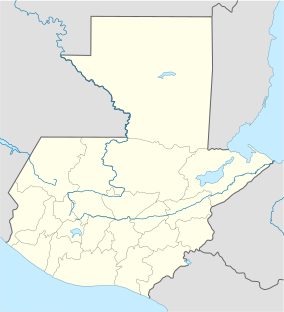Sipacate-Naranjo National Park facts for kids
Quick facts for kids Sipacate-Naranjo National Park |
|
|---|---|
|
IUCN Category IV (Habitat/Species Management Area)
|
|
| Location | Escuintla, Guatemala |
| Length | 20 km (12 mi) |
| Width | 1 km (0.62 mi) |
| Area | 20 km2 (7.7 sq mi) |
| Elevation | 1 m (3.3 ft) |
| Established | Acuerdo Gubernativo 06-09-69 |
| Visitors | allowed |
| Operator | CONAP |
The Sipacate-Naranjo National Park is a special place found on the Pacific coast of Escuintla in Guatemala. It's like a long, narrow strip of nature, about 20 kilometers (12 miles) long and 1 kilometer (0.6 miles) wide. This park stretches between the coastal towns of Sipacate and El Naranjo.
This amazing park is home to different types of environments. You can find thick mangrove forests, calm lagoons, and wide, sandy beaches here. It's a protected area, which means it's kept safe for all the plants and animals that live there.
Contents
What is a National Park?
A national park is a large area of land that a country protects because of its natural beauty, wildlife, or historical importance. These parks are managed by the government to keep them safe for future generations. They also allow people to visit and learn about nature.
Sipacate-Naranjo National Park was officially created in 1969. Its main goal is to protect the unique coastal ecosystems and the animals that depend on them.
Plants of the Park
The park is famous for its mangrove forests. Mangroves are special trees and shrubs that grow in salty water along coastlines. They have unique roots that help them breathe and stand firm in the mud.
Types of Mangroves
You can find several kinds of mangroves here. These include the white mangrove (Laguncularia racemosa), which has pale bark. There's also the black mangrove (Avicennia nitida or Avicennia germinans), known for its dark bark.
Another common type is the red mangrove (Rhizophora mangle), which has roots that look like stilts. These roots help the tree stand tall in the water.
Other Trees and Plants
Besides mangroves, other interesting trees grow in the park. The Mexican palmetto (Sabal mexicana) is a type of palm tree. You might also see the guiana chestnut (Pachira aquatica), which is sometimes called the "money tree." These plants are important parts of the park's ecosystem.
Animals of the Park
Sipacate-Naranjo National Park is a vital home for many animals. It's especially important for several types of turtles and a wide variety of birds.
Sea Turtles and Their Reproduction
The sandy beaches of the park are very important for sea turtles. Several endangered species come here to lay their eggs. This means their babies hatch on these very beaches.
The turtles you might find include the olive ridley (Lepidochelys olivacea), which is one of the smallest sea turtles. There's also the green turtle (Chelonia mydas), known for its greenish fat. The huge leatherback turtle (Dermochelys coriacea), the largest living turtle, also visits. Finally, the hawksbill turtle (Eretmochelys imbricata), with its beautiful shell, also lays eggs here.
Other Reptiles
Besides sea turtles, other reptiles live in the park. You might spot iguanas basking in the sun. There are also different kinds of freshwater turtles that live in the lagoons and waterways.
Birds of the Park
The park is a paradise for birdwatchers! Over 90 different bird species have been seen here. Some birds live in the park all year round, while others are migratory. This means they travel long distances to spend part of the year in the park.
You can see large groups of herons (Ardeidae) nesting in the trees. Cormorants (Phalacrocoracidae), pelicans (Pelecanidae), and ibises (Threskiornithidae) are also common. You might also spot plovers, dotterels, lapwings (Charadriidae), and different types of gulls (Laridae) near the water.
Birds of Special Concern
Some bird species in the park are very important to protect. They might be facing threats in other parts of Guatemala. These include:
- Pied-billed Grebe (Podilymbus podiceps)
- Brown pelican (Pelecanus occidentalis)
- Great White Egret (Ardea alba)
- Snowy Egret (Egretta thula)
- Little Blue Heron (Egretta caerulea)
- Tricolored Heron (Egretta tricolor)
- Green Heron (Butorides virescens)
- Yellow-crowned Night Heron (Nyctanassa violacea)
- Boat-billed Heron (Cochlearius cochlearius)
- Roseate Spoonbill (Platalea ajaja)
- Wood Stork (Mycteria americana)
- Black-necked Stilt (Himantopus mexicanus)
- Least Tern (Sterna antillarum)
These birds are carefully watched to make sure they stay safe and healthy in the park.
Why is the Park Important?
Sipacate-Naranjo National Park is very important for several reasons. It protects unique coastal habitats like mangrove forests, which act as natural barriers against storms. They also provide nurseries for many fish and shellfish.
The park also helps protect endangered sea turtles by providing safe nesting grounds. It's a crucial stopover for migratory birds, helping to keep their populations healthy. By protecting this area, we help keep the balance of nature and ensure these amazing plants and animals can thrive for years to come.
See also
In Spanish: Parque nacional Sipacate-Naranjo para niños


